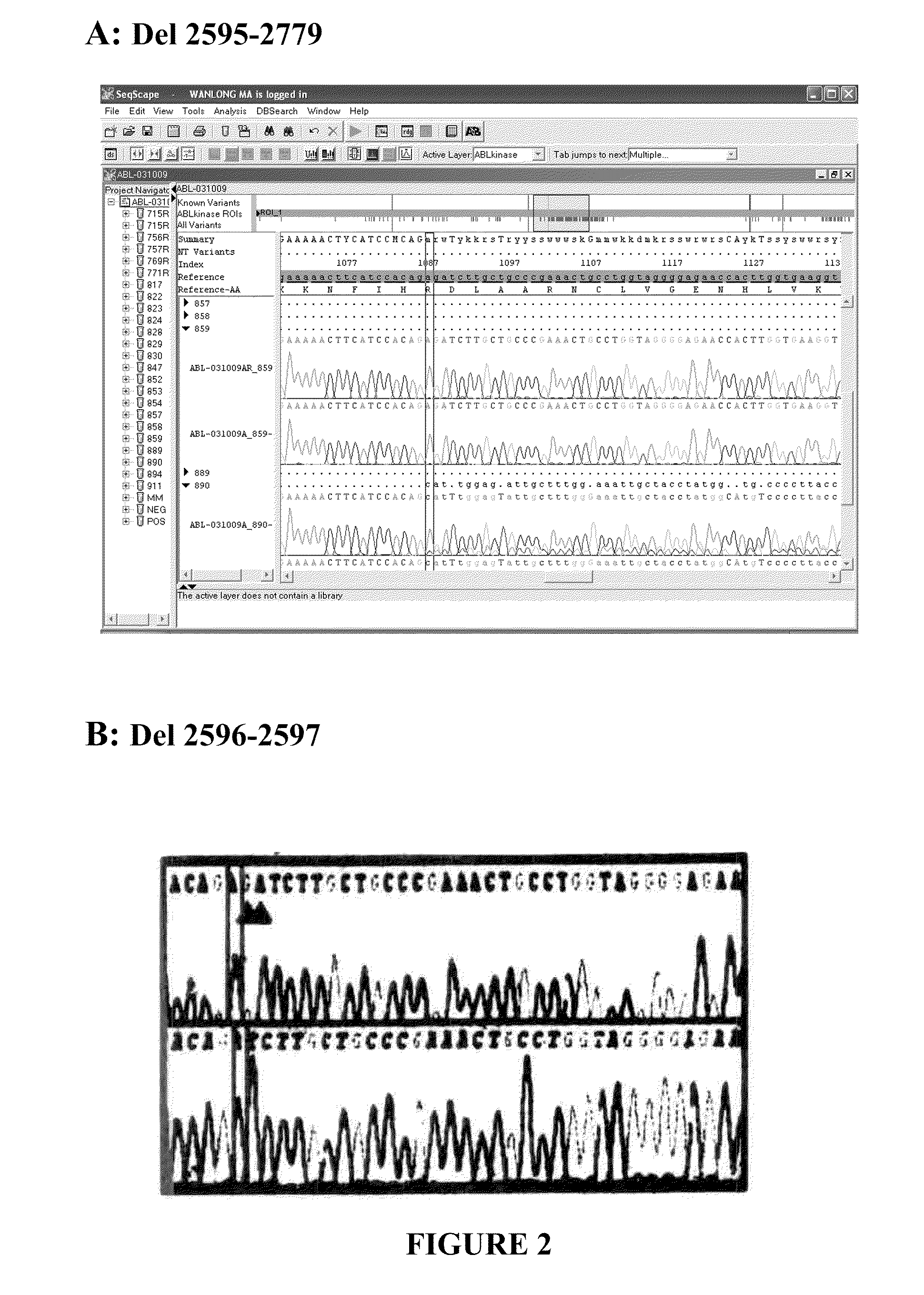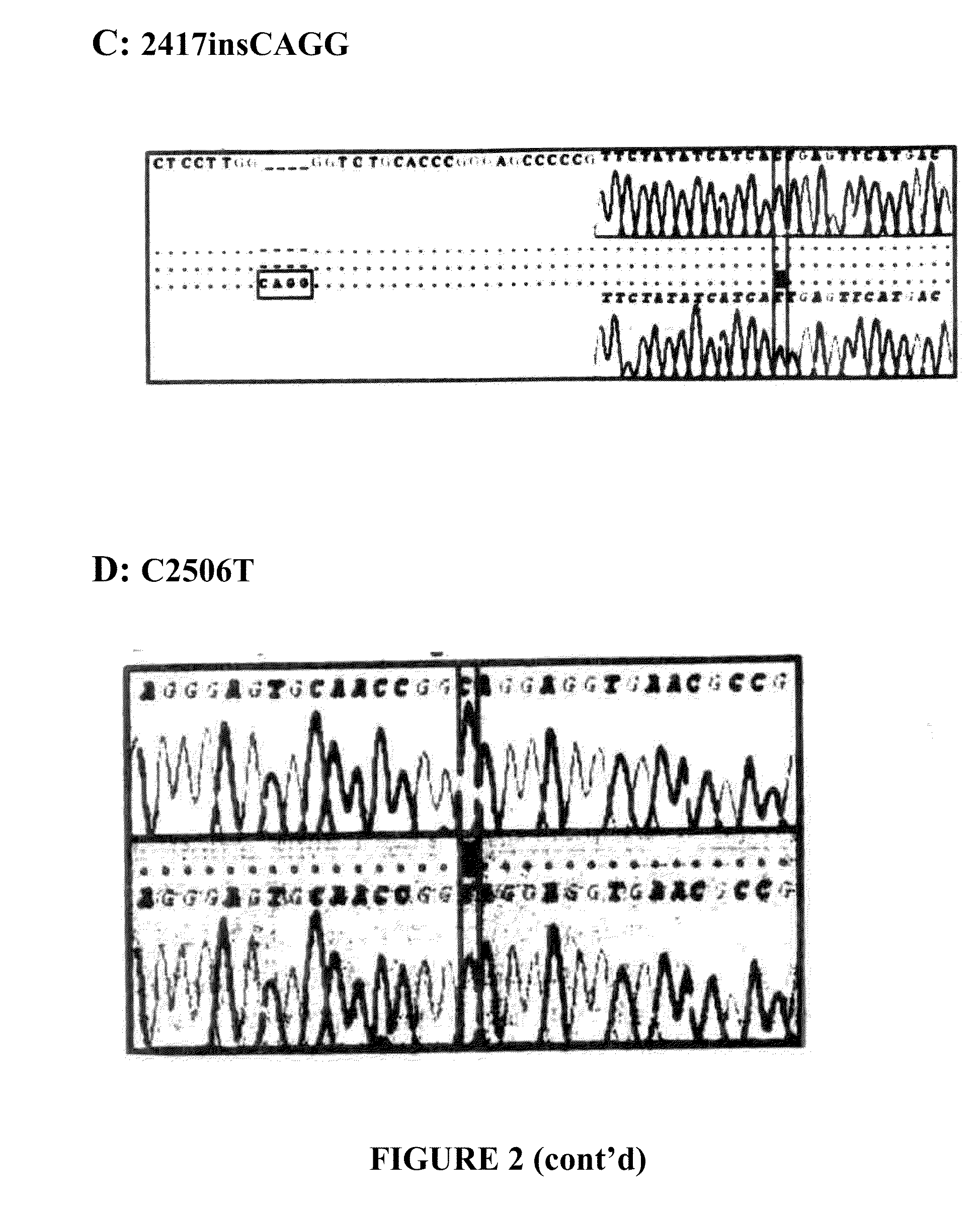Bcr-abl truncation mutations
a technology of bcr and abl, which is applied in the field of bcrabl variants and resistance to kinase inhibitor therapy, can solve the problems of resistance to imatinib remaining a major problem, undifferentiated blood cells to proliferate, and failure to mature, so as to reduce the viability or growth rate of cells, reduce the viability of genetically modified cells, and reduce the effect of viability
- Summary
- Abstract
- Description
- Claims
- Application Information
AI Technical Summary
Benefits of technology
Problems solved by technology
Method used
Image
Examples
example 1
[0194]Patients: Peripheral blood samples were collected from CML patients with or without imatinib resistance. Some of imatinib resistant patients were also resistant to nilotinib and dasatinib. The diagnosis of CML was established based on the examination of bone marrow morphology, cytogenetic, FISH, and molecular studies. The majority of tested samples were fresh, but a significant number used cells frozen in freezing mix and stored at −70° C.
[0195]Peripheral Blood Samples: Venous blood (5-8 ml) were collected from patients diagnosed with CML using BD Vacutainer™ CPT™ tubes (Beckton Dickenson, NJ, USA, Catalog number: 362760) by venous puncture. Peripheral mononuclear cells and platelets were isolated using manufacturer's protocol. Briefly, venous blood collected into the CPT™ tube was mixed with the anticoagulant present in the tube by inversion. The blood sample was centrifuged at 1500-1800 RCF for 20 min at room temperature (18° C.-25° C.). Plasma was removed f...
example 2
BCR-ABL Mutation Detection and Analysis
[0198]Amplification of the kinase domain of BCR-ABL gene: The kinase domain of the BCR-ABL gene was amplified by semi-nested polymerase chain reaction (PCR) using the cDNA derived from CML patient's mRNA as template. Semi-nested PCR was carried out with outer forward, inner forward primer and reverse PCR primers, sequences of which shown below:
Outer forward primer (BCR-F):TGACCAACTCGTGTGTGAAACTC(SEQ ID NO: 21)Reverse primer (ABL-R2):TCCACTTCGTCTGAGATACTGGATT(SEQ ID NO: 22)Inner forward primer (ABL-F1):CGCAACAAGCCCACTGTCT(SEQ ID NO: 23)
[0199]Outer forward primer SEQ ID NO: 21 anneals to BCR exon b2 and the reverse primer SEQ ID NO: 22 anneals to the junction of ABL exon 9 and 10. This ensures that un-translocated ABL gene will not be amplified. The second round of PCR (semi-nested PCR) was carried out with using an inner forward primer that anneals to ABL exon 4 (SEQ ID NO: 23) and reverse primer SEQ ID NO: 22. The semi-nested PCR generated a 86...
PUM
| Property | Measurement | Unit |
|---|---|---|
| temperature | aaaaa | aaaaa |
| temperatures | aaaaa | aaaaa |
| pH | aaaaa | aaaaa |
Abstract
Description
Claims
Application Information
 Login to View More
Login to View More - R&D
- Intellectual Property
- Life Sciences
- Materials
- Tech Scout
- Unparalleled Data Quality
- Higher Quality Content
- 60% Fewer Hallucinations
Browse by: Latest US Patents, China's latest patents, Technical Efficacy Thesaurus, Application Domain, Technology Topic, Popular Technical Reports.
© 2025 PatSnap. All rights reserved.Legal|Privacy policy|Modern Slavery Act Transparency Statement|Sitemap|About US| Contact US: help@patsnap.com



